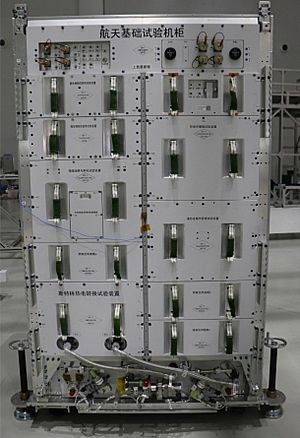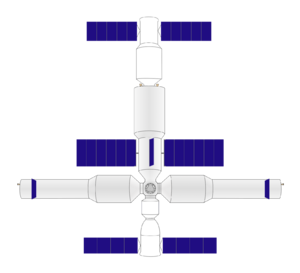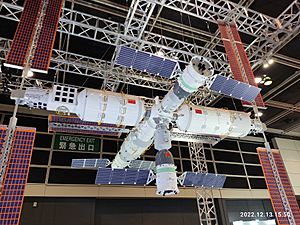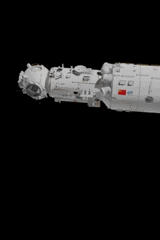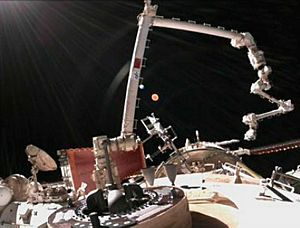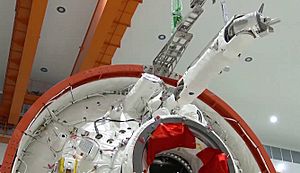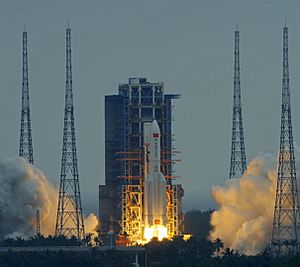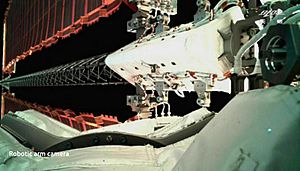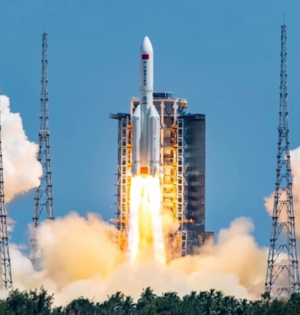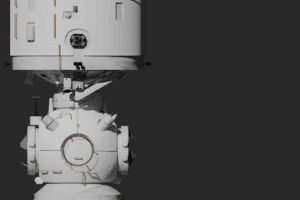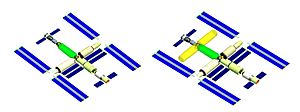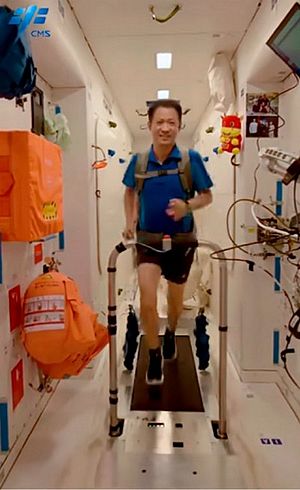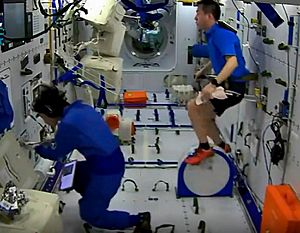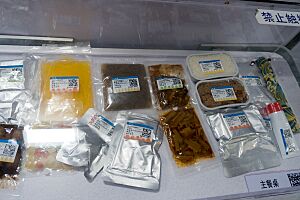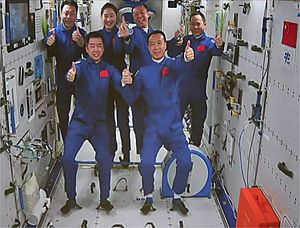Tiangong space station facts for kids

A rendering of the station with the Tianhe at centre of picture, a Tianzhou on its aft port, the Wentian on its starboard port to the left, the Mengtian on its portside port to the right and two Shenzhou spacecraft, sharing its multi-docking hub
|
|
| Station statistics | |
|---|---|
| Crew |
|
| Launch | 29 April 2021 (Tianhe) 24 July 2022 (Wentian) 31 October 2022 (Mengtian) ~2026 (Xuntian) |
| Launch pad | Wenchang, LC-101 |
| Mass | ~100,000 kg (220,000 lb) |
| Length | ~55.6 m (182 ft) |
| Diameter | ~39 m (128 ft) |
| Pressurised volume | 340 m3 (12,000 cu ft) Habitable: 122 m3 (4,310 cu ft) |
| Perigee | 386.4 km (240.1 mi) |
| Apogee | 391.8 km (243.5 mi) |
| Orbital inclination | 41.47° |
| Orbital speed | 7.67 km/s (27,600 km/h; 17,200 mph) |
| Orbital period | 92.3 minutes |
| Days in orbit | 4 years, 7 months, 17 days as of 17 December 2025 |
| Days occupied | 3 years, 6 months, 11 days as of 17 December 2025 |
| Statistics as of 25 November 2025 (unless noted otherwise) |
|
| Configuration | |
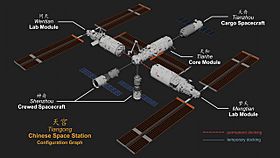
Station elements as of April 2024
(exploded view) |
|
| Tiangong | |||||||||||
|---|---|---|---|---|---|---|---|---|---|---|---|
| Simplified Chinese | 天宫 | ||||||||||
| Traditional Chinese | 天宮 | ||||||||||
| Literal meaning | "Heavenly Palace" | ||||||||||
|
|||||||||||
| Official name | |||||||||||
| Simplified Chinese | 天宫空间站 | ||||||||||
| Traditional Chinese | 天宮空間站 | ||||||||||
| Literal meaning | "Heavenly Palace Space Station" | ||||||||||
|
|||||||||||
The Tiangong space station (meaning "Heavenly Palace" in Chinese) is a special home in space. China built and operates this station. It is a place where astronauts live and work for long periods.
Tiangong is made of different parts, called modules, that connect in space. It orbits Earth between 340 and 450 kilometers high. This is China's first space station designed for long-term use. It is a key part of China's space exploration plans.
The station is a platform for many science experiments. It helps scientists learn new things about space and technology. Tiangong is about one-third the size of the International Space Station.
Building the station used lessons learned from earlier Chinese space labs, Tiangong-1 and Tiangong-2. The first main part, the Tianhe module, launched on April 29, 2021. Two more laboratory modules, Wentian and Mengtian, joined it in 2022. Many missions with astronauts and cargo ships have visited the station since then.
Contents
What's in a Name?
The names for China's space projects are often very poetic. "Tiangong" means "Heavenly Palace." Other names include "Divine Vessel" for spacecraft and "Heavenly Ship" for cargo ships.
These names connect to ancient Chinese stories and myths. They inspire people and show national pride in space exploration.
The main parts of the station also have beautiful names:
- Tianhe means "Harmony of the Heavens." This is the core module.
- Wentian means "Quest for the Heavens." This is a science lab module.
- Mengtian means "Dreaming of the Heavens." This is another science lab module.
- The cargo ships are called Tianzhou, or "Heavenly Ship."
- A future space telescope will be called Xuntian, meaning "Touring the Heavens."
Why Tiangong is in Space
The main goals of the Tiangong space station are:
- To learn how to connect spacecraft in orbit.
- To practice having people live and work in space for a long time.
- To test new ways to resupply the station with food and fuel.
- To develop technology for future trips deeper into space.
The station also offers a place for many scientific studies. China hopes private companies will also get involved in space innovation. Even space tourism might be possible one day!
Scientific Research
Tiangong has many special racks for experiments inside. There are also platforms outside for experiments exposed to space. Over 1,000 experiments are planned for the station.
Scientists are even exploring growing food in space. They have grown rice and other plants to find sustainable food sources for astronauts.
Experiments cover many areas, including:
- Space life sciences and biotechnology.
- How fluids and fire behave in microgravity.
- Studying materials in space.
- Basic physics in microgravity, like cold atoms.
Education and Cultural Outreach
The space station hosts "space lectures" for students. Astronauts teach science lessons from orbit. They answer questions from classrooms across China. These lessons inspire young people to learn about science and technology.
The station also has amateur radio equipment. This allows radio enthusiasts worldwide to contact astronauts. It encourages students to pursue careers in science, technology, engineering, and math.
How Tiangong is Built
Tiangong is a "modular" space station. This means it's built from different parts launched separately. These parts then connect together in orbit. This design makes it more reliable and helps save costs.
The station's construction method is similar to Russia's Mir space station. China is the second country to use automatic docking for building a modular space station.
| Wentian robotic arm |
Chinarm robotic arm |
||||||||||||||||||||||||||||||||||||||||||||
| Solar array | Solar array | Docking port | Solar array | Solar array | |||||||||||||||||||||||||||||||||||||||||
| Wentian laboratory |
Tianhe core module |
Mengtian laboratory |
|||||||||||||||||||||||||||||||||||||||||||
| Solar array | EVA hatch | Docking port | Docking port | Solar array | |||||||||||||||||||||||||||||||||||||||||
| EVA hatch | Cargo airlock | ||||||||||||||||||||||||||||||||||||||||||||
Station Modules
The Tiangong station currently has three main modules. China plans to expand it to six modules starting in 2027.
- Tianhe Core Module (CCM): This is the main control center and living area. It provides life support for three astronauts. It also controls the station's movement and power. It has a kitchen, toilet, computers, and communication gear.
- Wentian Laboratory Module: This module adds more power and life support systems. It has a special airlock for astronauts to go outside on extravehicular activities (EVAs). Wentian also has internal and external racks for science experiments. It includes three extra sleeping areas for short stays.
- Mengtian Laboratory Module: This module focuses on more experiments. It has a cargo airlock to move items from inside to outside the station. Mengtian carries 13 experiment racks and 37 external platforms.
Both Wentian and Mengtian provide a special environment for science. Researchers can do experiments in microgravity (weightlessness). Experiments can also be placed outside to study the effects of space. Wentian focuses on life science, while Mengtian focuses on microgravity experiments.
Special robotic arms help move the laboratory modules into their final positions.
| Module | Launch time (UTC) | Launch vehicle (Flight No.) | Docking date (UTC) / position | Length | Diameter | Mass | Illustration | Ground image |
|---|---|---|---|---|---|---|---|---|
| Tianhe | 29 April 2021 03:23:15 | Long March 5B (Y2) | N/A | 16.6 m (54 ft) | 4.2 m (14 ft) | 22,500 kg (49,600 lb) |  |
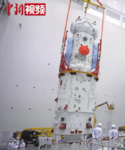 |
| The main module with living quarters, service area, and docking ports. | ||||||||
| Wentian | 24 July 2022 06:22:32 | Long March 5B (Y3) | 24 July 2022 19:13 (front)
30 September 2022 04:44 (front → starboard) |
17.9 m (59 ft) | 4.2 m (14 ft) | 23,200 kg (51,100 lb) | 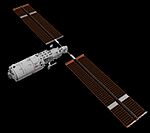 |
 |
| First lab module, also backs up core module controls. Has an EVA airlock and a 5-meter robotic arm. | ||||||||
| Mengtian | 31 October 2022 07:37:23 | Long March 5B (Y4) | 31 October 2022 20:27 (front)
3 November 2022 01:32 (front → port) |
17.9 m (59 ft) | 4.2 m (14 ft) | ~23,000 kg (51,000 lb) | 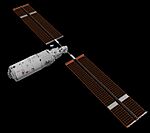 |
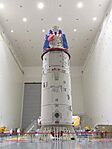 |
| Second lab module with a cargo airlock and system to move payloads. | ||||||||
Station Systems
Communication
Satellites called Tianlian II help the station communicate with Earth. They provide live video and audio links.
Docking
Tiangong uses a special docking system to connect spacecraft. This system is similar to those used on other space stations. It allows different modules and visiting ships to link up safely.
Power Supply
Solar panels on each module turn sunlight into electricity. This power is stored in batteries for when the station is in Earth's shadow. Cargo ships also bring fuel to help the station stay in its correct orbit.
Propulsion
The station uses special engines, called ion thrusters, to adjust its orbit. These advanced thrusters help keep Tiangong flying smoothly for many years.
Robotic Arms
Tiangong has five robotic arms. The longest one, called Chinarm, is 10 meters long. It is on the Tianhe module.
The Wentian module has a smaller, more precise 5-meter arm. This arm helps move experiments outside the station. The two main arms can even link up to extend their reach.
The Mengtian module has an arm to move experiments from inside to outside. It can also launch small satellites. Two other arms help move the lab modules into their final positions.
Co-orbit Modules
| Spacecraft | Launch time and International Designator | Launch vehicle | Operational date | Notes | Length | Diameter | Mass | On-orbit Image (Illustration) |
|---|---|---|---|---|---|---|---|---|
| Xuntian Space Station Telescope | 2026 (Planned) | Long March 5B (Planned) | 2027 (Planned) | Will share the same orbit and periodically dock with Tiangong | 14 m (46 ft) | 4.5 m (15 ft) | 15,500 kg (34,200 lb) | |
| This planned space telescope will orbit near Tiangong. It will dock with the station for maintenance. Xuntian will have a large mirror and a powerful camera. It will image a huge part of the sky over ten years. | ||||||||
Building Tiangong
Planning
China planned to build the Tiangong space station between 2020 and 2022. The goal was to create a T-shaped station with three large modules. Because of its modular design, Tiangong can be expanded in the future. This could allow more astronauts to visit.
Assembly
The construction of Tiangong began in April 2021. The first part, the Tianhe core module, launched on April 29, 2021. Cargo ships, called Tianzhou, delivered supplies.
Astronaut crews from Shenzhou missions then visited the station. The Shenzhou 12 crew were the first visitors in June 2021. They tested the station's systems and performed spacewalks. During one spacewalk, astronauts installed equipment and tested the robotic arm. The station also had to adjust its path a couple of times to avoid other satellites.
The Shenzhou 13 crew stayed for six months, a new record for China. They performed more spacewalks and prepared for future modules. In January 2022, the crew practiced moving a supply ship with the robotic arm.
The Wentian laboratory module launched on July 24, 2022. It docked with Tianhe and became the main entry point for spacewalks. Astronauts performed spacewalks from Wentian to install external equipment. On September 30, 2022, Wentian was moved to its permanent side port.
The Mengtian laboratory module launched on October 31, 2022. It docked with the station and was moved to its permanent port on November 3, 2022. This completed the station's T-shape. China announced that the construction of Tiangong was officially finished.
In December 2022, the Shenzhou 14 and Shenzhou 15 crews met in space. This was the first time six astronauts lived on Tiangong at once. This marked China's permanent presence in space. On December 17, 2024, astronauts Cai Xuzhe and Song Lingdong completed the longest spacewalk in history, lasting over 9 hours. They installed debris protection and maintained equipment.
Expansion
China plans to expand Tiangong from three to six modules. This expansion could start in 2027. New modules might include 3D printers, more robots, and systems to detect space debris. The station could grow to 180 tons and operate for at least 15 years.
Working with Other Countries
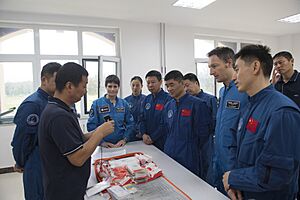
China built its own space station after being unable to join the International Space Station (ISS). However, Tiangong has welcomed cooperation with many countries. These include France, Sweden, Russia, and Italy.
The European Space Agency (ESA) astronauts trained with Chinese astronauts in 2017. They learned about survival and spacecraft operations. However, in January 2023, ESA decided not to send its astronauts to Tiangong.
The United Nations Office for Outer Space Affairs (UNOOSA) has helped select international experiments for Tiangong. Scientists from many countries, including Switzerland, Poland, Germany, and Canada, have projects on board. For example, one experiment studies how weightlessness affects cancer growth.
China has said it welcomes foreign astronauts to visit Tiangong. In 2025, China and Pakistan signed an agreement. This agreement will send the first foreign astronaut to the Tiangong Space Station. This Pakistani astronaut will be a payload expert on a short mission.
Life Aboard Tiangong
Crew Activities
Astronauts on Tiangong follow China Standard Time for their daily schedule. They wake up around 7:00 AM and talk with Mission Control in Beijing. Work usually starts at 8:00 AM. They take a nap around 1:30 PM and have breaks for meals.
The station has special lighting to mimic daylight, dusk, and night on Earth. This helps astronauts keep a normal sleep schedule.
Tiangong uses smart technology to help astronauts. They use tablet computers to find and organize items. Everything has a QR code! The station also has a Wi-Fi network for wireless communication.
Food and Personal Hygiene
Astronauts enjoy over 120 different types of food. Meals include shredded pork, kung pao chicken, and various teas. Cargo ships bring fresh fruits and vegetables. Food is prepared to be easy to eat in space. Condiments like Sichuan pepper sauce add flavor, as taste can change in microgravity.
Tiangong has the first microwave oven in space. This lets astronauts enjoy hot meals. The Shenzhou 21 mission also delivered an air fryer. Astronauts have used it to cook barbecue chicken wings and grilled steak!
The Tianhe module has living quarters for the crew. It includes three sleeping areas, a space toilet, and a shower. There is also gym equipment to help astronauts stay fit. Each sleeping area has a window, headphones, and ventilation. The Wentian module has three more sleeping areas for short stays.
How Tiangong Operates
Since June 5, 2022, Tiangong has always had astronauts living on board. Usually, three astronauts are there, but it can support up to six. Mission Control in Beijing manages all operations. A rescue spacecraft is always ready in case of an emergency.
Crewed Missions
The first crewed mission, Shenzhou 12, lasted 90 days. Most missions since Shenzhou 13 last about 180 days (six months).
The Shenzhou 20 crew returned to Earth on November 14, 2025. They used the Shenzhou 21 spacecraft for their return. The Shenzhou 22 crew launched on November 25, 2025, and is currently on the station.
China is also testing a new spacecraft called Mengzhou. It will carry more astronauts and cargo. Mengzhou is designed for future lunar exploration.
Cargo Resupply
Tianzhou (Heavenly Vessel) spacecraft bring supplies to Tiangong. These robotic ships deliver food, water, fuel, and experiment equipment. They can carry about 6,000 kg of cargo.
List of Missions
- All dates are UTC.
- Ports are named based on the station's normal direction of travel.
- Key (Based on launch)
Uncrewed cargo spacecraft are in light blue colour Crewed spacecraft are in light green colour Modules are in beige colour
| Launch date (UTC) |
Docking date (UTC) | Undocking date (UTC) | Result | Spacecraft/Module | Launch vehicle | Launch site | Docking/berthing port | Duration |
|---|---|---|---|---|---|---|---|---|
| 29 April 2021, 03:23:15 |
N/A | N/A | Success | Tianhe | Long March 5B | N/A | N/A | |
| 29 May 2021, 12:55:29 |
29 May 2021, 21:01 |
27 March 2022, 07:59 |
Tianzhou 2 | Long March 7 | Tianhe port | 301 days, 10 hours, 58 minutes | ||
| 17 June 2021, 01:22:27 |
17 June 2021, 07:54 |
16 September 2021, 00:56 |
Shenzhou 12 | Long March 2F/G | Tianhe forward | 90 days, 14 hours, 8 minutes | ||
| 20 September 2021, 07:10:11 |
20 September 2021, 14:08 |
17 July 2022, 02:59 |
Tianzhou 3 | Long March 7 | Tianhe forward | 299 days, 12 hours, 51 minutes | ||
| 15 October 2021, 16:23:56 |
15 October 2021, 22:56 |
15 April 2022, 16:44 |
Shenzhou 13 | Long March 2F/G | Tianhe nadir | 181 days, 14 hours, 46 minutes | ||
| 9 May 2022, 17:56:37 |
10 May 2022, 00:54 |
9 November 2022, 06:55 |
Tianzhou 4 | Long March 7 | Tianhe aft | 183 days, 6 hours, 1 minute | ||
| 5 June 2022, 02:44:10 |
5 June 2022, 09:42 |
4 December 2022, 03:01 |
Shenzhou 14 | Long March 2F/G | Tianhe nadir | 181 days, 14 hours, 11 minutes | ||
| 24 July 2022, 06:22:32 |
24 July 2022, 19:13 |
N/A | Wentian | Long March 5B | Tianhe starboard | N/A | ||
| 31 October 2022, 07:37:23 |
31 October 2022, 20:27 |
N/A | Mengtian | Long March 5B | Tianhe port | N/A | ||
| 12 November 2022, 02:03:12 |
12 November 2022, 04:10 |
11 September 2023 08:46 |
Tianzhou 5 | Long March 7 | Tianhe forward | 303 days, 4 hours, 36 minutes | ||
| 29 November 2022, 15:08:17 |
29 November 2022, 21:42 |
3 June 2023, 13:29 |
Shenzhou 15 | Long March 2F/G | Tianhe forward | 185 days, 13 hours, 56 minutes | ||
| 10 May 2023, 13:22:51 |
10 May 2023, 21:16 |
12 January 2024, 08:02 |
Tianzhou 6 | Long March 7 | Tianhe aft | 246 days, 10 hours, 46 minutes | ||
| 30 May 2023, 01:31:13 |
30 May 2023, 08:29 |
30 October 2023, 12:37 |
Shenzhou 16 | Long March 2F/G | Tianhe nadir | 153 days, 2 hours, 15 minutes | ||
| 26 October 2023, 03:14:02 |
26 October 2023, 09:46 |
30 April 2024, 00:43 |
Shenzhou 17 | Long March 2F/G | Tianhe forward | 186 days, 13 hours, 9 minutes | ||
| 17 January 2024, 14:27:30 |
17 January 2024, 17:46 |
10 November 2024, 08:30 |
Tianzhou 7 | Long March 7 | Tianhe aft | 297 days, 14 hours, 44 minutes | ||
| 25 April 2024, 12:59:00 |
25 April 2024, 19:32 |
3 November 2024, 08:12 |
Shenzhou 18 | Long March 2F/G | Tianhe nadir | 191 days, 11 hours, 8 minutes | ||
| 29 October 2024, 20:27:34 |
30 October 2024, 03:00 |
29 April 2025, 20:00 |
Shenzhou 19 | Long March 2F/G | Tianhe forward | 181 days, 17 hours | ||
| 15 November 2024, 15:13:18 |
15 November 2024, 18:32 |
8 July 2025, 07:09 |
Tianzhou 8 | Long March 7 | Tianhe aft | 234 days, 12 hours, 37 minutes | ||
| 24 April 2025, 09:17 |
24 April 2025, 15:49 |
14 November 2025, 06:49 |
Partial failure | Shenzhou 20 | Long March 2F/G | Tianhe nadir | 203 days, 15 hours | |
| 14 July 2025, 21:34 |
14 July 2025, 21:34 |
style="background: #ececec; color: grey; vertical-align: middle; text-align: center; " class="table-na" | N/A | Success | Tianzhou 9 | Long March 7 | Tianhe aft | 155 days, 2 hours, 26 minutes | |
| 31 October 2025 15:44 |
31 October 2025 19:22 |
14 November 2025 06:49 |
Shenzhou 21 | Long March 2F/G | Tianhe forward | 13 days, 11 hours, 27 minutes | ||
| 25 November 2025 12:11 |
25 November 2025 15:50 |
N/A | Success | Shenzhou 22 | Long March 2F/G | Tianhe forward | 21 days, 8 hours, 10 minutes | |
| 2026 | N/A | N/A | N/A | Xuntian | Long March 5B |
End of Mission
Tiangong is designed to operate for 10 to 15 years. When its mission ends, the station will be guided to re-enter Earth's atmosphere. It will be directed to fall into uninhabited areas, usually over the ocean, to ensure safety.
Seeing Tiangong from Earth

Just like the ISS, you can sometimes see the Tiangong space station from Earth. It looks like a bright star moving across the sky. This happens when sunlight reflects off its shiny modules and solar panels. You can often spot it a few hours after sunset or before sunrise.
See also
 In Spanish: Estación espacial Tiangong para niños
In Spanish: Estación espacial Tiangong para niños
- International Space Station
- List of space stations
- Politics of outer space
- Science diplomacy


